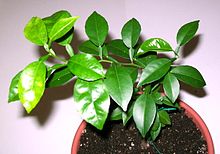- Sudachi
-
Sudachi 
Sudachi fruits Scientific classification Kingdom: Plantae (unranked): Angiosperms (unranked): Eudicots (unranked): Rosids Order: Sapindales Family: Rutaceae Genus: Citrus Species: C. sudachi Binomial name Citrus sudachi
Hort. ex ShiraiSudachi (Citrus sudachi; Japanese: スダチ or 酢橘) is a small, round, green citrus fruit which belongs to the papeda subgroup of citrus plants.
Sudachi is thought to be an ichang papeda - mandarin orange hybrid. Cultivated for centuries in parts of Japan, the fruit has remained relatively unknown elsewhere around the World. In Japan, the fruit is often used alongside two other closely related citrus fruits, the yuzu and the kabosu; this trio forms the base for ponzu sauce, among other culinary uses.
The fruit is also the symbol of the prefecture of Tokushima where the majority of the fruit is cultivated. Cultivation is centered mainly in the communities of Sanagouchi-son, Kamikatsu-cho and Kamiyama-cho.[1] The plant has white flowers which bloom in May and June. The fruits form in bunches, or tight clusters, and are harvested in the fall. Though sudachi fruits will eventually develop a yellow-orange rind color, they are normally harvested and used while still green.
A slice of this fruit is served with many traditional Japanese dishes which include fish, soba, udon, nabe, and even some alcoholic beverages. It is considered to have a zestier flavor and aroma than lemons or limes. It also boasts a higher calcium and ascorbic acid (vitamin C) content than lemons. Sudachi flavored products (such as ice cream, vodka coolers, ice pops, and soft drinks) can also be found in Japan, particularly in Tokushima Prefecture, where the fruit is sold cheaply. The actual fruit is regarded as a delicacy in other parts of Japan, and is often expensive. Compared to the related kabosu, sudachi is much smaller at 1 to 1.4 ounces as compared to 3.5 to 5 ounces.
In 2006, a Tokushima University research team published a report which suggests that the fruit may be effective in lowering glucose levels in diabetic patients.[citation needed] The team gave rats sudachi zest over a one year period and found the glucose levels fell and the health of the rats to improve. Although this effect has not yet been tested on humans, it can be potentially used for naturopathic medicine.
References

This Rutaceae article is a stub. You can help Wikipedia by expanding it.

